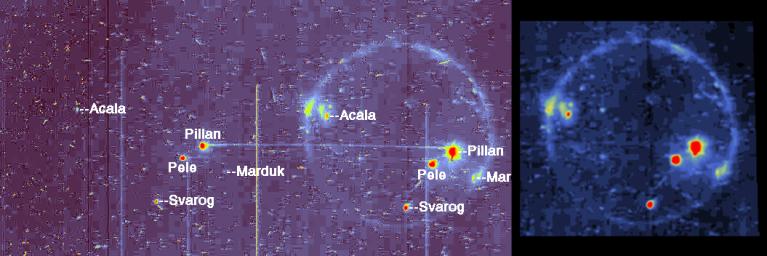
|
Io in Eclipse reveals High Temperature Hot Spots
- Click the image above for a larger view
- Full-Res JPEG (1054 x 352) (59.8 kB)
- Full-Res TIFF (1054 x 352) (323.3 kB)
Caption:
These views of Jupiter's moon Io in the eclipse of the large planet's shadow are color coded so blue to yellow to red represents increasing brightness. The bright spots indicate the locations of volcanic vents on Io, which are spewing hot lava. This image and other data from NASA's Galileo spacecraft indicate that the lava at Pillan Patera (marked Pillan) exceeded 1,700 degrees kelvin (2,600 degrees Fahrenheit) and may have reached 2,000 degrees kelvin (3,140 degrees Fahrenheit). The hottest eruptions on Earth today reach temperatures of about 1,500 kelvin (2,240 degrees Fahrenheit), but hotter lava erupted billions of years ago.
The left and middle parts of this picture show a "raw" image presented without processing other than color coding and labeling. Small, bright pixels and clusters of pixels represent radiation interference. The bright vertical lines are column blemishes in the imaging detector (CCD). An image of Io was acquired through both a 1- micrometer filter (left) and clear filter on the Galileo solid state imaging camera system. Both images were exposed on the same frame; however, during the left exposure, the spacecraft platform moved, causing the exposure to slide toward the clear filter position. The middle view disc combines the two exposures.
The brightest hot spot at Pillan Patera was saturated in both filters, but the platform motion resulted in a horizontal line between the Pillan positions. The unsaturated line allows measurement of Pillan's temperature. For further information, see a report in Science magazine, Vol. 281, July 3, 1998, page 87.
The third view (right) is the processed clear filter data. Diffuse glows, produced by energized particles interacting with gases, highlight both the rim of Io's disc and active plumes such as Marduk. North is to the top of the picture. The resolution is 14.6 kilometers (9 miles) per picture element (pixel), but camera motion smeared the hot spots over about nine pixels. They appear bigger than they really are; modeling indicates the actual hot spots are much smaller than the pixels. The image was taken on June 28, 1997 at a range of 1,440, 000 kilometers (890,000 miles).
Background Info:
JPL manages the Galileo mission for NASA's Office of Space Science, Washington, DC.
This image and other images and data received from Galileo are posted on the World Wide Web, on the Galileo mission home page at http://solarsystem.nasa.gov/galileo/ . Background information and educational context for the images can be found at http://www.jpl.nasa.gov/galileo/sepo .
Cataloging Keywords:
| Name | Value | Additional Values |
|---|---|---|
| Target | Io | |
| System | Jupiter | |
| Target Type | Satellite | |
| Mission | Galileo | |
| Instrument Host | Galileo Orbiter | |
| Host Type | Orbiter | |
| Instrument | Solid-State Imaging (SSI) | |
| Detector | ||
| Extra Keywords | Color, Eclipse, Plume, Shadow, Volcano | |
| Acquisition Date | ||
| Release Date | 1998-10-13 | |
| Date in Caption | 1997-06-28 | 1998-07-03 |
| Image Credit | NASA/JPL/University of Arizona | |
| Source | photojournal.jpl.nasa.gov/catalog/PIA01635 | |
| Identifier | PIA01635 | |
